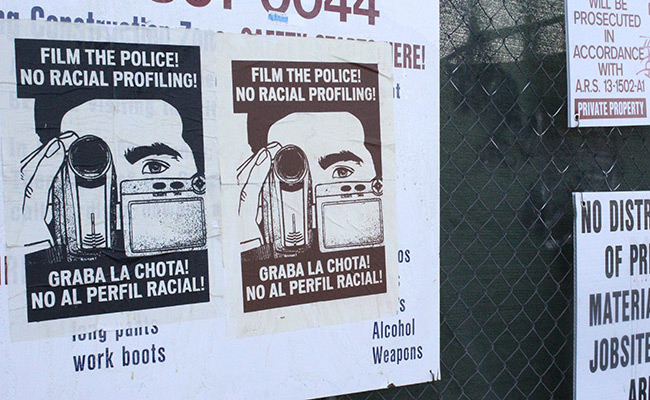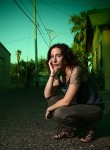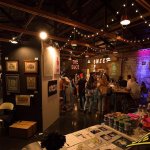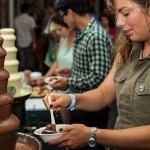I can tell you about the first piece of art I saw that stuck in my memory. I was angry, confused and 16 and figured that “art” meant “painting” or “large obnoxious sculpture sitting in front of a high rise building.” Luckily, I had a caring art teacher who wanted to expose some of us to a bit more.
 I walked into a room at the Philadelphia Art Museum and peered through 2 eye holes in a wooden wall and saw something I couldn’t explain. It was a landscape with flickering light, moving components, a figure, and what looked like an entrance into another world. Nothing in my ordinary life up to that point prepared me for that jarring moment when I realized that art wasn’t just one thing that took a specific form but could be a combination of elements that created an experience. The experience stayed with me. Years later in art school, I saw an image of Marcel Duchamp’s Etant Donnés (below left
I walked into a room at the Philadelphia Art Museum and peered through 2 eye holes in a wooden wall and saw something I couldn’t explain. It was a landscape with flickering light, moving components, a figure, and what looked like an entrance into another world. Nothing in my ordinary life up to that point prepared me for that jarring moment when I realized that art wasn’t just one thing that took a specific form but could be a combination of elements that created an experience. The experience stayed with me. Years later in art school, I saw an image of Marcel Duchamp’s Etant Donnés (below left
) and realized that it was the same piece.
As a person with little to no art education at the time, I was moved by a piece that incorporated numerous materials, media and concepts that was made before I was born, and by a man who supposedly abandoned art for chess. I always think of this when someone tells me that average people won’t appreciate conceptual or multimedia work. I was average but what made the work and the experience memorable was the very fact that it wasn’t what I expected art to be.
In Phoenix, when asked to give an example of a work of art, there is a tendency to mention a painting, photograph, or sculpture. There is also a tendency for some to preface the conversation with how they don’t know anything about art, and therefore didn’t really understand what they were looking at. The momentum of the Phoenix art scene has been going strong now for over 10 years but, more often than not, what we see are the three previously mentioned mediums. Interspersed amongst this work, artists have emerged with work that challenges these traditions.
 The contemporary art world does not function solely as a group of painters. Multimedia works utilizing technology, audience involvement, interventions, and site-specificity are a pervasive and customary inclusion in most contemporary exhibits. Yet, what we typically see at exhibits in Phoenix are standard material-based work. This isn’t to slight those working in traditional materials, or to say that multimedia works are the answer to our conceptual prayers, but to emphasize the importance of diverse exhibit content.
The contemporary art world does not function solely as a group of painters. Multimedia works utilizing technology, audience involvement, interventions, and site-specificity are a pervasive and customary inclusion in most contemporary exhibits. Yet, what we typically see at exhibits in Phoenix are standard material-based work. This isn’t to slight those working in traditional materials, or to say that multimedia works are the answer to our conceptual prayers, but to emphasize the importance of diverse exhibit content.
Working in a realm that most people are unfamiliar with is a risk, but can also be a gateway to a different process of understanding creativity and aesthetic experience. By setting up an unexpected environment that utilizes creative tactics, an audience is caught off guard. They register an experience rather than confront whether or not they are viewing art.
Some members of our community regularly take this gamble.
- Chris Danowski’s cross-cultural, intermedia and collaborative 9 Muses project (unexpectedly brought to a pause due to a damaged laptop).
- The previously published art zine Join and Cast Guide created by then ASU undergrads Jennifer Campbell and Catherine Akins that blended original artist submissions, writing, page design and a comprehensive snapshot of what was happening in the Phoenix art scene at that time.
- The Desert Art Lab who attempts to re-desert-ify the desert by distributing numbered cactus for participants to plant.
- The wheat-pasting of impromptu messages and imagery focused on attacking the anti-immigrant stance our state has taken (above right).
- The Tempe or ASU-based UrbanStew who regularly blends technology, sound, movement and other media to conduct multi-media projects and events.
- The work of resident artists at Combine Studios through ASU’s Desert Initiative.
Just next door to us we have a gigantic university with an Intermedia program that supplies this city with a flow of diversified, conceptual multimedia work. In order to retain the artists emerging from this program, they need to be involved in exhibits that appreciate and support them before having to leave for more sophisticated venues.
What makes these works and these people different are their ability to shift your perception. Instead of focusing on material and the physical process of a work, you become aware of many pieces fitting together. They are not as concerned with a standard art show setup and instead look at something relevant and necessary for themselves and the community.
Phoenix is a ripe environment to try anything new, with few barriers to putting on any type of event in any location at any time. The literal openness of our environment makes it so experimentation is invited and not restricted. In other words: no one except ourselves is stopping us from trying something different.







